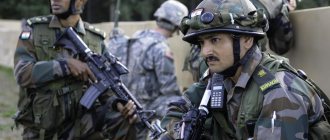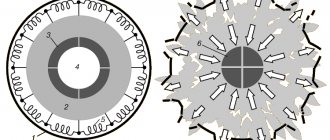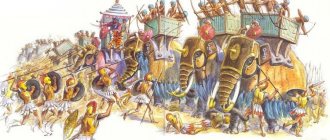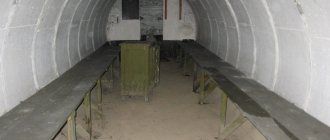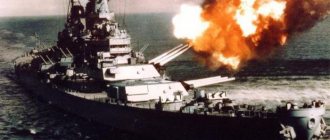How Pakistan became a nuclear power
The uncontrolled chain reaction of fission of heavy nuclei and thermonuclear fusion reactions underlie the action of nuclear weapons. The course of development of countries formed in the post-war period is similarly unpredictable. Today, the USA (since 1945), Russia (first the Soviet Union, since 1949), Great Britain (since 1952), France (since 1960), China (since 1964), India (since 1974) have acquired nuclear weapons g.), Pakistan (since 1998) and DPRK (since 2012). Israel is also considered to have nuclear weapons. As can be seen from the list, at the end of the last century, a completely unexpected companion joined the “Nuclear Club” - the Islamic Republic of Pakistan, formed only in 1947 as a result of the division of the territory of British India. It borders with India, Afghanistan, Iran and China. Since Pakistan is the second largest country with a Muslim population, after it acquired nuclear weapons, people began to say that the Muslim world had demonstrated its ability to compete on the world stage in such a specific area. But we will not combine the concepts of “religion” and “politics”, but will pay attention to the objective reasons for the emergence of nuclear weapons development in this young country.
Zulfiqar Ali Bhutto: "Pakistan will eat grass or leaves, even suffer from hunger, but will create a nuclear bomb"
“Land of the Pure” - this is how the name of the state we are interested in is translated. This name was proposed by Chaudhuri Rahmat Ali, who once studied at Cambridge. Many people know that this state was formed through the efforts of the Muslim League - as a result of many years of contradictions between different religious groups in British India. Kashmir remains a disputed region to this day. Pakistan is officially supported by its powerful ally, the United States. It is necessary to consider Pakistan's nuclear program taking into account the specifics of the entire South Asia region to which it belongs. The conflicting interests of India, China, Pakistan, India's desire for a high international status based on the development of technical industries, nuclear weapons in an unstable situation - all this points to the potential threat of conflict with the use of nuclear weapons. Yet neither India nor Pakistan violated international legal norms, since they did not sign the Treaty on the Non-Proliferation of Nuclear Weapons. In Pakistan, it all started in response to the development of nuclear power in India.
Short-range ballistic missile "Ghaznevi" Maximum range: up to 320 km Accuracy: 250 m Warhead: conventional or nuclear 12–20 kilotons
Armed conflicts between them occurred in 1947–1948, 1965, 1971, 1999. Therefore, countries are still interested in creating means of mutual “deterrence and deterrence.” But this has its own difficulties, since nuclear deterrence generates the proliferation of new weapons, which makes deterrence more difficult and less sustainable. The Pakistan Atomic Energy Commission is the only organization that specialized in nuclear research in the early 1970s. The 1974 tests in neighboring India caused real panic in Pakistan. Like a number of other countries, Pakistan carried out research with the goal of creating nuclear weapons without declaring the idea of a “peaceful atom.” But it was also very useful, there were not enough energy resources: 80% was exported, the situation largely remains the same. By the 1950s, the development of nuclear energy had already begun, but the scientific and technical base, as well as raw materials, was sorely lacking. There was no suitable infrastructure either.
At first, the reactors were tested and operated on US fuel. The first of them was launched in 1965 and had a capacity of only 10 MW. The most important example and stimulus for development were the developments of India. It was its successes that initially prompted the Pakistanis to declare their intention to create a nuclear-weapon-free zone in South Asia. There were intentions to join the Treaty on the Non-Proliferation of Nuclear Weapons as a non-nuclear power. But even if India had supported these sentiments then, nothing other than political will would have prevented countries from creating nuclear weapons secretly, under the guise of scientific research on uranium enrichment to obtain much-needed nuclear fuel for nuclear power plants. But after the 1971 war that separated Bangladesh and India's 1974 nuclear tests, peace talk began to subside. The parties essentially came to an arms race.
Pakistani Prime Minister Zulfiqar Ali Bhutto set the task of creating a nuclear bomb. He himself expressed himself quite clearly about the effort these developments cost the country: Pakistan “will eat grass or leaves, even suffer from hunger, but will create a nuclear bomb.”
Abdul Qadeer Khan - father of Pakistan's nuclear bomb
There were clearly not enough specialists in Pakistan. Abdul Qadir Khan is a person closely associated with the explosions of the first Pakistani nuclear bomb at the Chagai test site and further developments. Abdul Qadir Khan came from a Pashtun family that moved to Pakistan. He received an excellent European education, including in Germany, where he studied to become a metallurgical engineer, and then defended his doctoral dissertation. New prospects then opened up for him. He worked in a physics laboratory in Amsterdam and participated in secret research on uranium enrichment for the European uranium consortium Urenco.
I was in Belgium in 1971 when the Pakistani army surrendered East Pakistan and suffered humiliation. (...) I looked at these scenes with horror. When India tested its bomb in 1974, I was living in the Netherlands and working in the nuclear field. It was a very rewarding experience for me.
Returning to Pakistan in 1975, Khan found himself in great demand as a specialist and headed the nuclear program. Khan received at his disposal a research laboratory for industrial uranium enrichment, which was later named after him. In parallel, the Pakistan Atomic Energy Commission, headed by Munir Ahmad Khan, was developing a nuclear bomb based on plutonium. Subsequently, both programs were combined. There are also suggestions that technical information could have been obtained from China. The bomb was created at a research laboratory in Kahuta in northern Pakistan. More than 1,000 uranium enrichment centrifuges produced enough fissile material for 30–52 nuclear warheads. As a result, more than 100 years after Antoine Henri Becquerel discovered the radioactivity of uranium, a country he probably had no idea about exploded its own nuclear bomb. The first explosion occurred on May 28, 1998, followed by five more underground nuclear explosions, all at a test site in Balochistan province on the border with Afghanistan.
Chagai-I - Pakistan's first nuclear test on May 28, 1998
By the way, the United States then imposed a number of sanctions against Pakistan. The goal was to sign the Comprehensive Nuclear Test Ban Treaty and introduce a ban on the export of nuclear materials and military technologies to other countries. These goals were not achieved. Abdul Qadir Khan was subsequently accused of illegally selling nuclear weapons technology, centrifuges for uranium production, equipment and weapons delivery vehicles to various countries and organizations. In February 2004, after a meeting with President Musharraf, Khan admitted his guilt on national television. He was placed under house arrest, foreign investigations were suppressed. In later interviews, Khan said that the trade in nuclear materials and equipment was carried out with the knowledge of management.
Benazir Bhutto, a former prime minister, a woman amazing in her views and talents, who became the head of the government of Pakistan, said that, having won the elections, she would allow foreigners to interrogate Khan on this issue. But at the end of December 2007 she was killed; the new leadership did not favor foreign investigators to interrogate Khan.
The launch of the Hatf-VII Babur cruise missile - essentially an analogue of the earlier versions of the Tomahawk.
At the moment, Pakistan's nuclear arsenal is ahead of India in both size and equipment, and the nuclear program is developing rapidly. Any government has “patriotic feelings” for it. Data on the location of warehouses and the size of accumulated charges vary greatly. It is stated that all warehouses and laboratories are carefully guarded and that the entire program is aimed at protecting the sovereignty of Pakistan itself, and not supplying any global organizations. The Pakistani nuclear bomb was indeed the first example of successful development in a Muslim country; this fact was actively used in propaganda even by Z. A. Bhutto himself.
It is interesting to look at the names of modern Pakistani missiles. Some do relate to Islamic history:
- Abdali (“Abdali”) - in honor of Ahmad Shah Abdali, the Pakistani emperor;
- Babur (“Babur”) - in honor of the medieval commander Muhammad Babur, who conquered India;
- Ghauri (“Ghauri”, “Ghori”) - in honor of Sultan Muhammad Ghori, the conqueror of India;
- Ghaznavi (“Ghaznavi”) - in honor of Mahmud Ghaznavi, the Pakistani ruler and commander;
- Hatf (“Hatf”) - after the name of the sword of the Prophet Muhammad;
- Nasr (“Nasr”) - translated from Arabic means “Victory”;
- Ra'ad ("Raad") - "Thunder". The Ra'ad nuclear cruise missile is designed to be launched from a JF-17 aircraft;
- Shaheen (“Shaheen”) is a bird of prey of the falcon genus. Lives in Pakistan;
- Taimur (“Timur”) - in honor of Tamerlane;
- Tipu (“Tipu”) - in honor of the monarch who conquered South India.
Abdul Kadir Khan founded several technical educational institutions. He was always convinced that education could change the situation in the country for the better. Even in conditions of low living standards, modern scientific developments in Pakistan make it possible to create thermonuclear weapons and intercontinental ballistic missiles. The nuclear program is successfully developing and increasing its potential. The main factor - whether new weapons will be used or remain a deterrent - remains relations with India.
Shaheen-II medium-range ballistic missile
What is going on?
On February 14, a terrorist attack occurred in India. A suicide bomber killed 46 soldiers by blowing up a passing convoy. The Jaish-e-Mohammad organization, which openly advocates the annexation of the problematic region to Pakistan, took responsibility for the explosion. India followed up by accusing its negligent neighbors not only of supporting criminals, but also of involvement in organizing a specific terrorist attack.
There is a certain meaning in India's claims to the Pakistani authorities. The mentioned organization is officially banned on the territory of its native state. However, the formal obstacle does not prevent terrorists from calmly attacking disputed lands, coming precisely from Pakistan. I don’t presume to judge, but the feigned naivety of Islamabad reminds me very much of the supposedly innocent phrases of Russian officials about “ichtamnet” vacationers and any “military trader.”
So Pakistan listened to the accusations and demanded evidence, but instead of providing it, India decided to take a truly brave and crazy step. On February 26, new surface-to-air missiles were tested. Having enjoyed the good performance of the weapon, India decided to use force outside the training ground. Already on February 27, the disputed territory was bombed from the air. According to the commanders of the operation, the target of the attack was the camp of that same terrorist group.
Pakistan howled about the violation of rules and laws, although in reality it could have simply thanked its neighbors for clearing out a dangerous group. After all, if Islamabad has nothing to do with illegal groups, the shelling saved it from unnecessary trouble - indeed, an organization banned in Pakistan cannot fight exclusively with Indians? The Muslims also did not have time to give a diplomatic slap in the face: while they were recalling their ambassador, his Indian colleague had been sitting at home for a long time and only watched the development of events on TV.
The unfortunate victims of the attack protested so much that they shot down two Indian fighters. Apparently, crocodile tears were wiped away with the launcher remote control.
What kind of fists do they wave?
In search of useful information, I came across the resource The Times of India, whose article I will briefly share. The publication states that Pakistan has between 140 and 150 warheads. The forces are approximately equal - for example, the Indian side will be able to show from 130 to 140 charges. The data is for last year, but nuclear weapons usually do not reproduce by budding, so this is enough information for a general presentation.
Do not rush to be fooled by the bitten elbows of the publication. India is also not perfect. On February 26, the local military successfully tested surface-to-air missiles, firing two guns at once and waving their fists at the enemy. Pakistan is modestly silent, and the neighbors are quietly turning gray - it seems that the children are not tired of the game yet.
To give you an idea of the scale of the arsenal, before the final signing of the Budapest Memorandum, Ukraine owned 176 ballistic missiles, as well as nuclear weapons. Try to imagine how the Transcarpathian and Donetsk regions divided the arsenal and started rubbing it in each other’s faces - bravo, you are an observer of international organizations. If the regions began to fire at each other, and you are watching this process, standing in the center of Kyiv... It seems that now you understand the people of Kashmir very well.
It’s frightening that the current “Indian surprises” will only need a few minutes to fly to their nearest neighbor. Pakistan will spend the same amount of time if necessary. If we make allowances for the speed of reaction, we get a rather bad-smelling conflict with every chance of the coming of a nuclear winter.
Where did “ichthamnets” come from?
Terrorists fighting on the side of Pakistan, but not formally defending its interests, are undercover at a little less than 0%. The logical chain looks like this: “Jaish-e-Muhammad” - “Harakat ul-Mujahideen” - “Harkat-ul-Jihad-al-Islamiya”. The first club of peaceful intellectuals represents the interests of Pakistan in present-day Kashmir; its progenitor fought against the Soviet occupiers in Afghanistan back in 1985. Symbolically, the chain begins with the more powerful organization Harkat-ul-Jihad-al-Islamiya, which was the main backbone of the Pakistani military in the fight against the USSR. In general, the course has been followed quite successfully; the logical chain can be traced back to 1984.
The first big statement from Jaish-e-Mohammad came in 1999; It was the Indians who became the victims. Then the terrorists went through a rebranding procedure, trading six prisoners in exchange for an Indian Airlines plane with passengers on board. One of the people who was released early was Masood Azhar, the current leader and main ideologist of the group. Interestingly, both Pakistani officials and the Afghan Taliban, who took over the plane during the negotiations, helped the terrorists. A funny symbiosis. The friendship continued in 2001: then the militants of the Army of God (Lashkar-Taiba) helped their brothers attack the Indian parliament.
In 2008, Jaish-e-Muhammad tried to win public attention at any cost: terrorists planned to blow up a synagogue in distant New York, and in the same year, American aviation was threatened with “Stingers.” Fortunately for the whole planet, the militants did not succeed. However, I no longer want to look surprised. After all, the direction in which the group is working completely coincides with the ideological line of the official government of Pakistan.
What, they just took it and attacked? How unusual. Well, you have to! Especially against the backdrop of the fact that Pakistan even denied its participation in the Kargil war - where is a modest terrorist attack?!
The frantic zeal of the fanatics is quite understandable, because amid the squabbling of the two states, an important ingredient of the nuclear cocktail is being lost. The parties to the conflict are divided by religion. In Pakistan, as one might guess, Muslims are concentrated, and in India (which is logical) Hindus. Kashmir itself is more than half (60%) filled with supporters of Islam. However, if the DeM militant's hand trembles, he will be replaced by a business brother from the Army of God, which in the spring of 2000 was already killing both Hindus and Sikhs.
The conflict could not be more acute, especially when the outlines of missiles can be seen behind the combatants. Actually, now we’ll go over to them, our dear ones.
